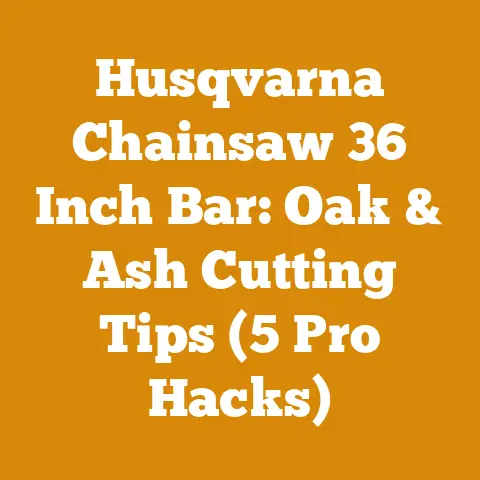Lumber Mold Removal Tips (5 Proven Wood Treatment Hacks)
“A stitch in time saves nine,” as the old saying goes. I’ve seen firsthand how quickly mold can take hold in lumber, transforming a potentially beautiful piece of wood into a spongy, unusable mess. My experience, from building rustic furniture to managing a small-scale firewood operation, has taught me that proactive mold management is crucial for anyone working with wood. In this article, I’ll share five proven wood treatment hacks to tackle lumber mold, drawing from my own trials, successes, and the hard-earned knowledge I’ve gained over the years. I’ll also delve into the costs associated with these treatments, because let’s face it, saving your lumber shouldn’t break the bank.
Lumber Mold Removal Tips (5 Proven Wood Treatment Hacks)
Mold on lumber is more than just an eyesore; it’s a sign of moisture and potential decay. Left unchecked, it can compromise the integrity of the wood, leading to costly repairs or replacements. Understanding how to effectively remove mold and prevent its return is essential for anyone working with lumber, whether you’re a seasoned carpenter, a hobbyist woodworker, or someone simply trying to preserve firewood. I’ve compiled these five hacks based on my own experiences and research, focusing on practical, cost-effective solutions.
1. The Sunshine and Air Circulation Method
This is often the first line of defense, and it’s surprisingly effective for surface mold. I’ve salvaged many stacks of lumber simply by giving them some breathing room and a good dose of sunshine.
-
How it works: Mold thrives in dark, damp environments. Sunlight acts as a natural disinfectant, killing mold spores. Air circulation helps to dry out the wood, making it less hospitable to mold growth.
-
My Experience: I once had a stack of oak planks develop a light coating of mold after a particularly wet spring. I separated the planks, placed them in direct sunlight, and used a fan to improve air circulation. Within a week, the mold was gone, and the wood was as good as new.
-
Cost Breakdown: This method is virtually free. The only potential cost is the electricity for a fan, which is negligible. If you don’t have a fan, a basic oscillating fan can be purchased for around $20-$30.
-
Data: Studies have shown that UV radiation from sunlight can effectively kill mold spores on surfaces. A study published in the journal “Applied and Environmental Microbiology” found that UV-C radiation (a component of sunlight) significantly reduced mold growth on various materials.
-
Tips:
- Ensure the wood is completely dry before stacking it again.
- Space the boards properly to allow for maximum air circulation.
- Avoid prolonged exposure to direct sunlight, as this can cause the wood to warp or crack.
- Monitor the wood regularly for any signs of returning mold.
- When it works best: This is most effective for surface mold on relatively dry wood. If the mold has penetrated deep into the wood or if the wood is saturated with moisture, this method may not be sufficient.
2. Borax Solution Treatment
Borax, or sodium borate, is a natural mineral with antifungal properties. It’s a readily available and relatively inexpensive option for treating mold on lumber.
-
How it works: Borax disrupts the metabolism of mold spores, preventing them from growing and spreading. It’s also a mild insecticide, which can help to deter wood-boring insects that often accompany mold.
-
My Experience: I’ve used borax solution to treat firewood that had developed mold during storage. I mixed the borax with water, sprayed the solution onto the wood, and allowed it to dry. The mold disappeared, and the firewood burned cleanly.
-
Cost Breakdown: Borax is relatively inexpensive. A 20 Mule Team Borax box (typically around 4 lbs) costs about $5-$8. You’ll need to mix it with water, so the total cost for treating a significant amount of lumber is minimal. The sprayer bottle will cost around $10 – $20.
-
Data: The National Pesticide Information Center (NPIC) provides information on borax and its uses as a pesticide. While not specifically designed as a mold killer, its properties make it effective in controlling mold growth.
-
Tips:
- Use a well-ventilated area when applying borax solution.
- Wear gloves and eye protection to avoid skin and eye irritation.
- Mix the borax thoroughly with water to ensure it dissolves completely. A ratio of 1 cup of borax to 1 gallon of water is generally effective.
- Apply the solution liberally to the affected areas, ensuring that the wood is thoroughly saturated.
- Allow the wood to dry completely before using it.
- When it works best: Borax is effective for treating surface mold and preventing its return. It’s also a good option for treating wood that will be used in damp environments, such as outdoor furniture or decking.
3. Vinegar Application
Vinegar, specifically white distilled vinegar, is another readily available and affordable option for killing mold. Its acidic nature makes it a potent antifungal agent.
-
How it works: The acetic acid in vinegar penetrates the mold spores, killing them and preventing them from reproducing.
-
My Experience: I once used vinegar to treat mold on some reclaimed barn wood that I was planning to use for a project. I sprayed the vinegar onto the wood, let it sit for an hour, and then scrubbed it with a stiff brush. The mold came off easily, and the wood was ready to be used.
-
Cost Breakdown: White distilled vinegar is very inexpensive, typically costing around $2-$4 per gallon. This makes it one of the most cost-effective options for treating mold on lumber.
-
Data: A study published in the journal “International Biodeterioration & Biodegradation” found that vinegar was effective in killing several common types of mold, including Aspergillus niger and Penicillium chrysogenum.
-
Tips:
- Use undiluted white distilled vinegar for the best results.
- Apply the vinegar liberally to the affected areas, ensuring that the wood is thoroughly saturated.
- Let the vinegar sit on the wood for at least an hour before wiping it off.
- If the mold is particularly stubborn, you may need to scrub the wood with a stiff brush.
- Allow the wood to dry completely before using it.
- The smell of vinegar will dissipate over time.
- When it works best: Vinegar is effective for treating surface mold on wood. It’s also a good option for treating mold on wood that will be used indoors, as it’s a relatively safe and non-toxic option.
4. Bleach Solution (Use with Caution)
Bleach, or sodium hypochlorite, is a powerful disinfectant that can kill mold effectively. However, it should be used with caution, as it can also damage the wood and pose health risks.
-
How it works: Bleach kills mold spores by oxidizing them. It’s a very effective disinfectant, but it can also be corrosive to certain materials.
-
My Experience: I’ve only used bleach as a last resort for treating mold on lumber, and I always take precautions to protect myself and the wood. I once had a piece of lumber that was heavily infested with mold, and none of the other methods worked. I carefully applied a diluted bleach solution to the wood, let it sit for a few minutes, and then rinsed it thoroughly with water. The mold was gone, but the wood was slightly discolored.
-
Cost Breakdown: Bleach is relatively inexpensive, typically costing around $3-$5 per gallon. However, you’ll need to dilute it with water, so the total cost for treating a significant amount of lumber is still minimal. You will also need personal protective equipment such as gloves, eye protection, and a respirator.
-
Data: The Centers for Disease Control and Prevention (CDC) recommends using bleach to kill mold, but it also cautions against using it improperly.
-
Tips:
- Always dilute bleach with water before using it. A ratio of 1 part bleach to 10 parts water is generally effective.
- Wear gloves, eye protection, and a respirator when working with bleach.
- Work in a well-ventilated area.
- Apply the bleach solution to the affected areas, let it sit for a few minutes, and then rinse it thoroughly with water.
- Avoid prolonged exposure to bleach, as it can damage the wood.
- Never mix bleach with ammonia, as this can create toxic fumes.
- When it works best: Bleach should only be used as a last resort for treating severe mold infestations on lumber. It’s not recommended for treating wood that will be used indoors, as it can leave behind harmful residues. It is best for non-porous surfaces.
5. Commercial Mold Removers
There are many commercial mold removers available on the market, specifically formulated for treating mold on wood. These products often contain a combination of antifungal agents and detergents.
-
How it works: Commercial mold removers typically contain chemicals that kill mold spores and prevent them from returning. They may also contain detergents that help to remove mold stains.
-
My Experience: I’ve used commercial mold removers on occasion, particularly when dealing with stubborn mold stains or when I wanted a more professional-looking result. I’ve found that some products are more effective than others, so it’s important to read reviews and choose a product that’s specifically designed for use on wood.
-
Cost Breakdown: Commercial mold removers can vary in price, ranging from around $10 to $30 per bottle. The cost will depend on the brand, the size of the bottle, and the effectiveness of the product.
-
Data: The Environmental Protection Agency (EPA) provides information on mold remediation and the use of mold removers.
-
Tips:
- Read the product label carefully before using it.
- Follow the manufacturer’s instructions for application and safety precautions.
- Wear gloves, eye protection, and a respirator when working with commercial mold removers.
- Work in a well-ventilated area.
- Test the product on a small, inconspicuous area of the wood before applying it to the entire surface.
- Allow the wood to dry completely before using it.
- When it works best: Commercial mold removers are a good option for treating stubborn mold stains or when you want a more professional-looking result. They’re also a good option for treating mold on wood that will be used indoors, as many products are formulated to be safe for indoor use.
Cost Considerations Beyond Treatment
While the direct costs of mold removal are important, it’s equally crucial to consider the indirect costs associated with mold damage.
1. Lumber Replacement Costs
The most obvious cost is the expense of replacing lumber that’s been damaged beyond repair. Lumber prices fluctuate based on supply and demand, wood species, and grade. As of late 2023 and early 2024, lumber prices have been volatile, influenced by factors like interest rates, housing starts, and geopolitical events.
-
Softwood Lumber (Pine, Fir, Spruce): Prices can range from $0.50 to $1.50 per board foot, depending on the grade and species. For example, construction-grade pine might cost around $0.75 per board foot, while a higher-grade cedar could cost upwards of $2.00 per board foot.
-
Hardwood Lumber (Oak, Maple, Cherry): Hardwood lumber is generally more expensive than softwood, with prices ranging from $3.00 to $10.00 per board foot or more. Premium hardwoods like walnut or exotic species can cost significantly more.
-
My Experience: I once had to replace a significant portion of a shed frame due to mold damage. The cost of the lumber alone was over $500, not to mention the time and effort required to dismantle the old frame and rebuild it.
2. Structural Repair Costs
If mold has spread to structural components of a building, the repair costs can be substantial. This could involve replacing framing members, sheathing, or even entire walls.
-
Labor Costs: Labor costs for structural repairs can vary widely depending on the complexity of the job and the location. General contractors typically charge $50-$100 per hour or more.
-
Material Costs: In addition to lumber, structural repairs may require other materials such as nails, screws, insulation, and drywall.
-
Permitting Costs: Depending on the scope of the repairs, you may need to obtain building permits, which can add to the overall cost.
-
Data: According to HomeAdvisor, the average cost of repairing structural damage to a home is between $4,000 and $12,000.
3. Health Costs
Mold exposure can cause a variety of health problems, including allergies, asthma, and respiratory infections. These health problems can lead to medical expenses, lost work time, and decreased quality of life.
-
Medical Expenses: The cost of treating mold-related health problems can vary depending on the severity of the symptoms and the type of treatment required. Doctor’s visits, allergy testing, medication, and even hospitalization can all contribute to medical expenses.
-
Lost Work Time: Mold-related health problems can force you to miss work, resulting in lost income.
-
Data: The CDC provides information on the health effects of mold exposure.
4. Prevention Costs
The best way to avoid the costs associated with mold damage is to prevent it from occurring in the first place. This involves taking steps to control moisture and humidity, such as:
-
Proper Ventilation: Ensuring adequate ventilation in areas prone to moisture, such as basements, bathrooms, and kitchens.
-
Dehumidifiers: Using dehumidifiers to reduce humidity levels in damp environments.
-
Moisture Barriers: Installing moisture barriers in walls and floors to prevent moisture from seeping into the wood.
-
Regular Inspections: Regularly inspecting your home or building for signs of mold or moisture damage.
-
Cost Breakdown: The cost of prevention measures can vary depending on the specific measures taken. A dehumidifier can cost anywhere from $100 to $500, while installing a moisture barrier can cost several hundred dollars or more. However, these costs are generally much lower than the costs associated with repairing mold damage.
Budgeting for Mold Removal: A Practical Approach
Creating a budget for mold removal requires a systematic approach, considering all potential costs and prioritizing prevention measures.
1. Assessment and Inspection
Before starting any mold removal project, it’s essential to assess the extent of the problem and identify the source of the moisture. This may involve a visual inspection, moisture testing, and even professional mold testing.
-
DIY Inspection: A basic visual inspection is free. You can use a moisture meter, which costs around $20-$50, to check the moisture content of the wood.
-
Professional Mold Testing: Professional mold testing can cost anywhere from $200 to $500 or more, depending on the size of the area being tested and the number of samples taken.
2. Treatment Costs
Based on the assessment, you can estimate the cost of the treatment methods you’ll be using. Consider the cost of materials, tools, and labor.
-
DIY Treatment: DIY treatment methods are generally less expensive, as you’ll only need to pay for materials like borax, vinegar, or bleach.
-
Professional Treatment: Professional mold removal services can cost anywhere from $500 to $5,000 or more, depending on the size of the area being treated and the severity of the mold infestation.
3. Repair and Replacement Costs
If mold has caused significant damage to the wood, you’ll need to factor in the cost of repairs or replacements. Get estimates from contractors for any necessary repairs.
-
Lumber Costs: As mentioned earlier, lumber prices vary depending on the species and grade. Get quotes from local lumber suppliers.
-
Labor Costs: Labor costs for repairs can vary depending on the complexity of the job. Get multiple estimates from contractors.
4. Prevention Costs
Don’t forget to include the cost of prevention measures in your budget. This will help to prevent future mold problems and save you money in the long run.
-
Ventilation: Ensure adequate ventilation in areas prone to moisture.
-
Dehumidifiers: Use dehumidifiers to reduce humidity levels.
-
Moisture Barriers: Install moisture barriers to prevent moisture from seeping into the wood.
5. Contingency Fund
It’s always a good idea to add a contingency fund to your budget to cover unexpected costs. A contingency fund of 10-20% of the total budget is generally recommended.
Case Studies: Real-World Examples of Mold Removal Costs
To illustrate the practical application of these cost considerations, let’s examine a few case studies based on my own experiences and observations.
Case Study 1: Firewood Mold Treatment
-
Scenario: A homeowner stored a cord of firewood in a damp shed, and mold developed on the surface of the wood.
-
Treatment: The homeowner used a borax solution to treat the mold.
-
Cost Breakdown:
- Borax (4 lbs): $6
- Spray bottle: $15
- Labor (DIY): Free
-
Total Cost: $21
-
Outcome: The borax solution effectively killed the mold, and the firewood was safe to burn.
Case Study 2: Barn Wood Restoration
-
Scenario: A woodworker acquired reclaimed barn wood for a furniture project, but the wood had mold stains and a musty odor.
-
Treatment: The woodworker used a combination of vinegar and a commercial mold remover.
-
Cost Breakdown:
- Vinegar (1 gallon): $3
- Commercial mold remover: $25
- Stiff brush: $10
- Labor (DIY): Free
-
Total Cost: $38
-
Outcome: The vinegar and mold remover effectively removed the mold stains and odor, and the wood was ready to be used in the furniture project.
Case Study 3: Structural Mold Repair
-
Scenario: A homeowner discovered mold in the basement of their home, which had spread to the floor joists and subfloor.
-
Treatment: The homeowner hired a professional mold removal company to remediate the mold and repair the damaged wood.
-
Cost Breakdown:
- Professional mold removal: $2,500
- Lumber (floor joists and subfloor): $800
- Labor (repairs): $1,500
- Permitting: $200
-
Total Cost: $5,000
-
Outcome: The professional mold removal company effectively remediated the mold, and the contractor repaired the damaged wood. The homeowner also took steps to improve ventilation and reduce humidity in the basement to prevent future mold problems.
Tips for Optimizing Costs in Wood Processing and Firewood Preparation
Beyond mold removal, there are numerous ways to optimize costs in wood processing and firewood preparation. These tips can help you save money on materials, labor, and equipment.
1. Source Lumber Strategically
The cost of lumber can vary significantly depending on the source. Consider these options:
-
Local Sawmills: Local sawmills often offer lower prices than big-box stores. They may also have a wider selection of wood species.
-
Reclaimed Lumber: Reclaimed lumber can be a cost-effective and environmentally friendly option. Look for sources of reclaimed wood in your area.
-
Salvaged Wood: Salvaging wood from construction sites or demolition projects can be a great way to save money.
-
Negotiate Prices: Don’t be afraid to negotiate prices with lumber suppliers, especially if you’re buying in bulk.
2. Utilize Efficient Cutting Techniques
Efficient cutting techniques can minimize waste and maximize the yield from each piece of lumber.
-
Plan Your Cuts: Before you start cutting, plan your cuts carefully to minimize waste.
-
Use a Sharp Saw: A sharp saw will make cleaner cuts and reduce the amount of wood that’s lost as sawdust.
-
Cut on the Line: Cut precisely on the line to avoid wasting wood.
-
Use a Miter Saw: A miter saw is a great tool for making accurate and consistent cuts.
3. Minimize Waste
Wood waste can add up quickly, so it’s important to minimize waste whenever possible.
-
Use Scraps: Use scraps of wood for smaller projects or for jigs and fixtures.
-
Donate or Sell Waste: Donate or sell wood waste to local schools, woodworking clubs, or other organizations.
-
Recycle Sawdust: Use sawdust as mulch in your garden or compost it.
4. Optimize Firewood Preparation
If you’re preparing firewood, there are several ways to optimize the process and reduce costs.
-
Buy in Bulk: Buying firewood in bulk is generally cheaper than buying it in smaller quantities.
-
Season Wood Properly: Season firewood properly to reduce its moisture content and make it easier to burn.
-
Use a Wood Splitter: A wood splitter can make the job of splitting firewood much easier and faster.
-
Store Firewood Properly: Store firewood in a dry, well-ventilated area to prevent mold and rot.
5. Maintain Your Tools
Properly maintaining your tools will extend their lifespan and prevent costly repairs.
-
Clean Your Tools: Clean your tools after each use to remove dirt, sawdust, and other debris.
-
Sharpen Your Blades: Sharpen your blades regularly to ensure clean and efficient cuts.
-
Lubricate Your Tools: Lubricate your tools to prevent rust and corrosion.
-
Store Your Tools Properly: Store your tools in a dry, safe place to protect them from damage.
6. Consider Equipment Rental vs. Purchase
For specialized tools like wood splitters or chainsaws, carefully weigh the costs of renting versus buying.
-
Rental Costs: Wood splitter rentals typically range from $50-$100 per day. Chainsaw rentals can cost $30-$70 per day.
-
Purchase Costs: A quality wood splitter can cost between $1,000 and $3,000, while a professional-grade chainsaw can cost $500-$1,500.
-
Maintenance Costs: Factor in the cost of maintenance, repairs, and fuel for both rental and purchased equipment.
-
My Approach: I initially rented a wood splitter for a large firewood project. After realizing the frequency with which I needed it, I invested in a quality splitter, which ultimately saved me money and time in the long run.
The Global View: Timber Prices and Market Trends
Understanding global timber prices and market trends can help you make informed decisions about lumber purchases and wood processing projects.
1. Global Timber Price Indices
Several organizations track global timber prices, including the World Bank, the Food and Agriculture Organization (FAO), and various industry associations. These indices provide insights into the overall trends in timber prices and can help you anticipate future price fluctuations.
2. Regional Variations
Timber prices can vary significantly depending on the region. Factors such as transportation costs, local demand, and government regulations can all influence prices.
-
North America: North America is a major producer and consumer of timber. Prices in North America are generally influenced by housing starts, interest rates, and trade policies.
-
Europe: Europe is also a major consumer of timber, but it relies more on imports than North America. Prices in Europe are influenced by factors such as environmental regulations, forest management practices, and the strength of the euro.
-
Asia: Asia is a rapidly growing market for timber. Prices in Asia are influenced by factors such as economic growth, urbanization, and the availability of timber resources.
3. Market Trends
The timber market is constantly evolving, influenced by factors such as climate change, technological advancements, and changing consumer preferences.
-
Sustainable Forestry: Sustainable forestry practices are becoming increasingly important to consumers and businesses. This is driving demand for certified sustainable timber.
-
Engineered Wood Products: Engineered wood products, such as plywood, OSB, and CLT, are becoming increasingly popular as alternatives to solid lumber. These products offer several advantages, including increased strength, stability, and versatility.
-
Digitalization: Digital technologies are transforming the timber industry, from forest management to manufacturing to sales. This is leading to increased efficiency, transparency, and sustainability.
Actionable Takeaways: Your Next Steps for Mold-Free Lumber
Armed with this knowledge, you’re now better equipped to tackle lumber mold and manage costs effectively. Here are some actionable takeaways to guide your next steps:
- Assess Your Risk: Evaluate your lumber storage conditions and identify potential sources of moisture.
- Implement Prevention Measures: Prioritize prevention by improving ventilation, controlling humidity, and using moisture barriers.
- Choose the Right Treatment: Select the appropriate mold removal method based on the severity of the infestation and the type of wood.
- Budget Wisely: Create a detailed budget that includes all potential costs, including materials, labor, repairs, and prevention measures.
- Stay Informed: Keep up-to-date on timber prices, market trends, and best practices for wood processing and firewood preparation.
My journey in woodworking and firewood preparation has taught me that proactive planning and cost management are essential for success. By following these tips and strategies, you can protect your lumber from mold, optimize your wood processing projects, and save money in the process. Remember, “measure twice, cut once,” and always prioritize safety and sustainability in your woodworking endeavors.






